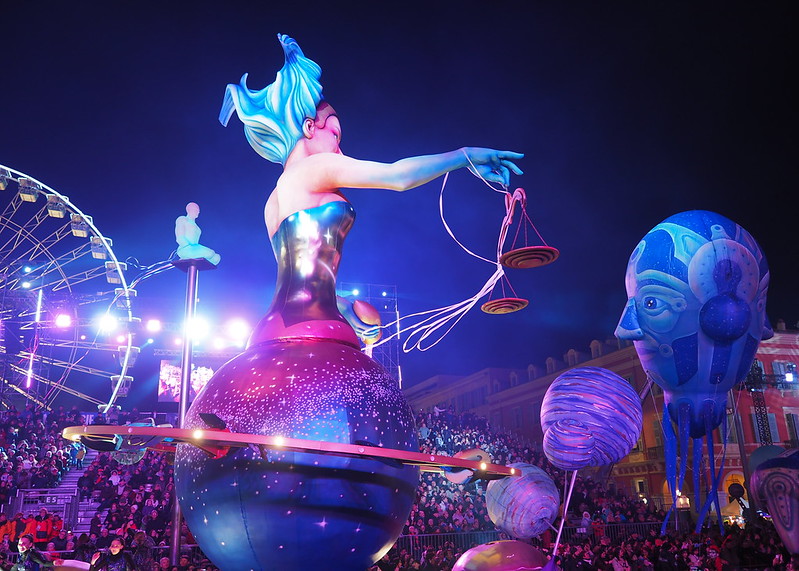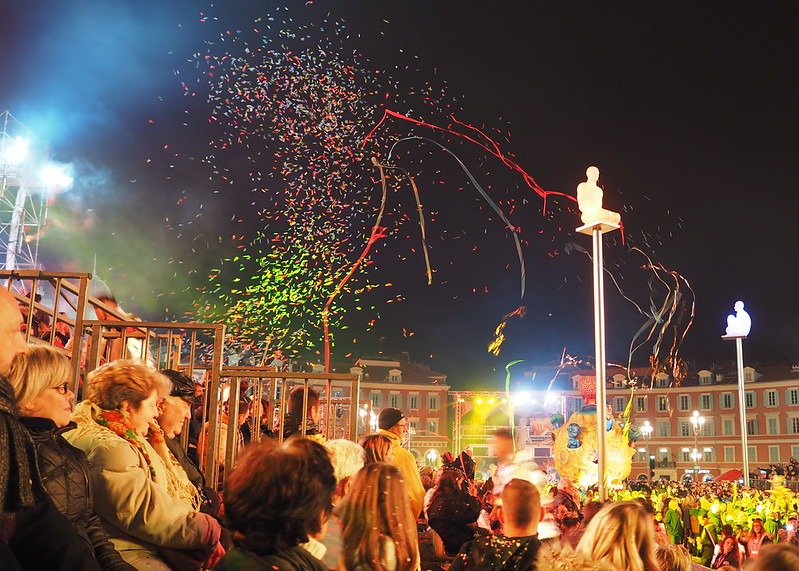Carnival de Nice
A Vibrant Celebration of Color and Joie de Vivre
2026/02/12 - 2026/02/26
Every February, the sun-drenched streets of Nice transform into a fantastical stage for the carnival festivities. This event, one of the world's largest carnivals, attracts over a million visitors to the French Riviera. For two weeks, the city pulsates with energy, offering a kaleidoscope of parades, music, and gastronomic delights that captivate both locals and tourists alike.
Main Attractions
Carnival Parade (Corso Carnavalesque)
The heart of the festival is the Corso Carnavalesque, the carnival parade. "Corso" means "procession" in Italian, while "Carnavalesque" means "carnival-like". Gigantic floats, some reaching up to 17 meters high, glide through the streets of Nice, their vibrant colors and intricate designs drawing gasps of awe from the crowd. The air fills with the sweet scent of mimosa flowers and the rhythmic beats of samba, as over 1,000 dancers and musicians from around the world create a mesmerizing spectacle. The undisputed star of the show is the enormous effigy of the Carnival King, its imposing presence symbolizing the grandeur of the festivities.
Flower Parade (Bataille de Fleurs)
A gentler yet equally enchanting event is the Bataille de Fleurs (Battle of Flowers), a floral parade that began in 1876 to celebrate the local flower industry. About 15 floats, lavishly decorated with thousands of fresh flowers, glide along the Promenade des Anglais. The air becomes perfumed with the delicate fragrance of roses, mimosas, and carnations as costumed performers toss flowers to the eager crowd. Each year, about 250,000 flowers and 21 tons of mimosa are used, with 80% sourced locally. The sight of soft petals brushing against outstretched hands, creating a living canvas of vibrant colors against the blue Mediterranean backdrop, is a feast for the senses and has become a signature event of the French Riviera.
Culinary Delights
The carnival is as much a treat for the taste buds as it is for the eyes. Local specialties take center stage, with the aroma of socca, a crispy chickpea pancake, wafting through the air. Street vendors offer pissaladière, a savory onion tart that melts in your mouth, while glasses of chilled rosé wine from nearby Provence vineyards provide refreshment. For those with a sweet tooth, the carnival's signature treat, the bugne - a light, crispy fritter dusted with powdered sugar - offers a delightful crunch that perfectly complements the festive atmosphere.
Cultural and Historical Background
The Nice Carnival boasts a rich history dating back to 1294, when Charles of Anjou, Count of Provence, mentioned spending "the joyous days of carnival" in the city. However, it wasn't until 1873 that the carnival took on its modern form, with the creation of an official festival committee.
For the people of Nice, the carnival is more than just a celebration; it's a time for spiritual liberation and social critique. The tradition of "Grosses Têtes" (Big Heads), giant papier-mâché heads worn by performers, dates back to the 19th century and is used to satirize politicians and celebrities, sometimes offering scandalous social commentary. Locals use this period to release everyday stress and enjoy the freedom to point out societal contradictions through laughter.
Moreover, during the carnival period, the use of the local dialect, Niçard, increases, strongly expressing regional identity. Economically, the carnival attracts about a million tourists during the winter off-season, significantly contributing to the survival of Nice's traditional tourism and flower industries.
Participants Voices
The Nice Carnival far exceeded my expectations. It's as lively as the Chinese Spring Festival, but the atmosphere is completely different. What impressed me most was the free-spirited atmosphere of the masked people. I also put on a mask and danced, and the people around me welcomed me warmly. The scent of mimosa reminded me of the osmanthus fragrance during Spring Festival, evoking both nostalgia and freshness. I tried the local dish called socca, which was familiar as it's similar to our spring pancakes. When I sent photos to my friends on social media, they were all envious and said they want to come together next year. I think this carnival is the best way to experience Western culture.
When I was planning my winter vacation, I stumbled upon this carnival by chance, and I'm so glad I came. Last night's parade was unlike anything I've ever seen before. I was captivated by the beauty of the illuminated floats, and the atmosphere of everyone dancing and singing together was so enjoyable that I couldn't help but join in. I also participated in a mask-making workshop, where the artisan explained the meanings behind various mask designs, which was fascinating. I realized that this carnival isn't just a festival, but a living cultural tradition.
Fun Facts
- Over 20 tons of confetti are used during the carnival parades - enough to fill an Olympic-sized swimming pool!
- Each float in the parade can take up to 700 hours to construct and decorate.
- The tradition of burning the Carnival King effigy at the end of the festival dates back to ancient rituals of renewal and purification.
- The Bataille de Fleurs uses approximately 100,000 flowers, with 90% of them grown locally.
- In 2001, the Carnival introduced an eco-friendly initiative, using biodegradable confetti made from corn starch.
Festival Dates
The Nice Carnival typically takes place in February.
The event schedule is subject to change. Please check the official website for the most up-to-date information.
Information
| Name | Carnival de Nice |
| Country | France |
| Area | Nice |
| Date | 2026/02/12 - 2026/02/26 |
| Link |
Upcoming Festivals
Whirling Dervishes Festival Turkey
A Mesmerizing Dance of Divine Love
2025/12/06Mevlana Celaleddin Rumi Commemoration Ceremony ( Şeb-i Arus ) Turkey
A Whirling Journey to Divine Love
2025/12/10Dia de la Virgen de Guadalupe Mexico
A Festival Weaving Faith, Fervor, and Mexican Identity
2025/12/11L'Escalade Switzerland
Geneva’s Grand Winter Festival of Courage, Chocolate, and Community
2025/12/12Umkhosi Wokweshwama South Africa
The Zulu First Fruits Festival—A Sacred Celebration of Land, Ancestors, and Renewal
2025/12/12Lucia Festival (St. Lucia's Day) Sweden
A Festival of Light Illuminating the Nordic Darkness
2025/12/15Las Posadas Mexico
The Luminous Quest for Sacred Shelter
2025/12/22Noche de Rabanos (Night of the Radishes) Mexico
A celebration blending art, farming heritage, and cultural traditions
2025/12/23Chant of the Sybil on Majorca Spain
A Medieval Prophecy Echoes Through Majorcan Christmas
2025/12/23‘Hatajo de Negritos’ and the ‘Hatajo de Pallitas’ Peru
A Christmas Festival of Rhythm, Faith, and Afro-Andean Heritage in Peru’s Ica Region

